December 13, 2013
has a wide selection of Pulps - Books - Old Time Radio - Audiobooks - Cassettes and lots more at great prices. More than 50 discounted items, supplies limited.
Dragnet is considered a classic program for a multitude of reasons. The memorable opening theme, classic lines, and dedication to detail and more have imprinted this program on American society permanently. One of the best aspects of Dragnet and the very reason for the show’s existence was its creator and star Jack Webb. Webb’s portrayal of Joe Friday takes center stage in Dragnet, Volume 8 from Radio Archives.
Jack Webb made sure that Joe Friday was a policeman that other policemen could relate to and that listeners enjoyed. Played almost to understated perfection, Friday walks listeners through every episode, unfurling the case as he sees it in stark detail. While most of his fictional peers were cracking wise on other shows, Webb took a different approach with Friday. Stripped down, essential dialogue in a tone that oftentimes bubbled with an emotional undercurrent was Friday’s trademark.
Webb also imparted a particular humanity to Joe Friday that many other fictional policemen and detectives of the era lacked. He remained a bachelor for the entire run of the show, living with his mother. He showed sympathy for those who deserved it and sarcasm for those who earned it. He playfully picked on his partners. He never rushed to violence first. In essence, Joe Friday was as real a cop as a fictional one could be, thanks to Jack Webb.
 Another latter-day Old Time Radio favorite which was unknown to most of the country at the time of its original run, "Let George Do It" offers a change of pace for fans of the hard-boiled crime show genre, and an opportunity to hear the popular Bob Bailey - later renowned for his portrayal of the title character in "Yours Truly, Johnny Dollar" - in his earliest major radio role.
Another latter-day Old Time Radio favorite which was unknown to most of the country at the time of its original run, "Let George Do It" offers a change of pace for fans of the hard-boiled crime show genre, and an opportunity to hear the popular Bob Bailey - later renowned for his portrayal of the title character in "Yours Truly, Johnny Dollar" - in his earliest major radio role.

Jack Webb made sure that Joe Friday was a policeman that other policemen could relate to and that listeners enjoyed. Played almost to understated perfection, Friday walks listeners through every episode, unfurling the case as he sees it in stark detail. While most of his fictional peers were cracking wise on other shows, Webb took a different approach with Friday. Stripped down, essential dialogue in a tone that oftentimes bubbled with an emotional undercurrent was Friday’s trademark.
Webb also imparted a particular humanity to Joe Friday that many other fictional policemen and detectives of the era lacked. He remained a bachelor for the entire run of the show, living with his mother. He showed sympathy for those who deserved it and sarcasm for those who earned it. He playfully picked on his partners. He never rushed to violence first. In essence, Joe Friday was as real a cop as a fictional one could be, thanks to Jack Webb.
The episodes featured in this volume are during a period of transition for Dragnet and for Joe Friday. Webb’s Friday had several partners performed by six different actors after the death of Barton Yarborough. Ben Alexander became his partner permanently as Frank Smith starting with #170 The Big Shot. Volume 8 features Jack Webb as Joe Friday at his best and meticulously restored for your listening enjoyment by Radio Archives. 10 hours. $29.98 Audio CDs / $14.99 Download.
Special 50% discount Offer
Bailey is heard here as George Valentine, a low-key Los Angeles private eye with a good sense of the ironic and a sharp eye for the scientific method of investigation. Less likely to be clubbed into unconsciousness by blackjack-wielding goons than most of his radio-detective colleagues, Valentine offers himself to clients as a sort of freelance troubleshooter -- bringing his services to the attention of the desperate thru cryptic classified newspaper advertisements. And like Bailey's later characterization of Johnny Dollar, the actor's interpretation of George Valentine is that of an intelligent, thinking man leavened by just a touch of world-weary cynicism.
The series was a west-coast-only feature for its entire 1946-54 run, heard over the stations of the Mutual-Don Lee network,
The twenty programs in this collection span the series' prime period, from 1946 to 1949. Don't miss this opportunity to "Let George Do It!" Regular Price $29.98 - Specially priced until December 19 for $14.99 Audio CDs / $7.49 Download.
Special 50% discount Offer
It really all began with Frank Sinatra. In January 1942, the twenty-six-year-old singer was riding the crest of phenomenal popularity. Wherever he appeared with Tommy Dorsey and his Orchestra, he was greeted with screams, sighs, and fainting spells from a faithful contingent of over stimulated female bobby-soxers, greeting his every phrase, motion, and intonation with loud and rapturous delight. Sinatra now felt he was ready for a solo career, even if his boss Tommy Dorsey said he was "a damn fool" for considering it.
The notion of a band vocalist going out on his or her own, without the musical and promotional support of a popular orchestra, was a fairly revolutionary concept in the early 1940s. By the end of the war, vocalists like Dick Haymes, Jo Stafford, Frank Sinatra, Helen Forrest, Perry Como, Andy Russell, and a host of others were the stars of music business, with many also appearing on their own network radio programs. With the recording ban lifted, local radio stations began a rapid movement toward disc jockey programs that highlighted popular vocalists, frequently scheduling live promotional interviews with the singers as part of their daily broadcasts. This programming strategy would, with time, grow into a format that would thrive long after big-time network radio had faded into memory.
In this collection, Radio Archives turns the spotlight on fourteen of the most popular vocalists and musical ensembles of the mid-20th century, appearing in thirty full length radio broadcasts dating from the last years of the war through the late 1950s. Regular Price $29.98 - Specially priced until December 19 for $14.99 Audio CDs / $7.49 Download.
Will Murray's Pulp Classics #40
by Norvell W. Page writing as Grant Stockbridge
Read by Nick Santa Maria. Liner Notes by Will Murray

For ten grim years, the Spider battled the underworld, imprinting his scarlet seal on the bodies of the criminals he slew. No one knew his name. His face was unknown. Pursued by the police, sought by the mob, the Master of Men crushed crime with a blazing intensity never witnessed before or since. Now he's back with a vengeance in a new series of audiobooks retelling his pulp-pounding exploits, as chronicled by Norvell W. Page, writing as Grant Stockbridge.
After three years of writing the Spider, Norvell Page suddenly dropped out. No one is sure why this was, but nervous strain due to overwork, along with making unforgiving monthly deadlines, are the likeliest explanations for Page abandoning the Spider series.
For several months, Emile C. Tepperman ghosted the series as Grant Stockbridge. Suddenly, Norvell Page returned. And he returned with a vengeance! Tepperman introduced a new character to the series, Ben Lasker, but Page ruthlessly obliterated him in the beginning of his return novel, The Man Who Ruled in Hell. Not content with that, Page introduced a new alternate identity for Richard Wentworth, safecracker Blinky MacQuade.
Following that riveting resurrection, Page penned Machine Guns Over the White House for the September, 1937 issue, in which he pulled out all the stops. What does the suicide of a United States Senator, a sinister schemer calling himself the Cobra, and a weird Hindu cult have in common? Only Richard Wentworth, called to the nation’s capital by a mysterious newspaper notice directed to his arachnid alter ego, suspects a link.
Before the gunsmoke clears, the Spider will have blazed a battle trail from the Capitol Building to the White House, to foil a madman’s coup intended to snuff out the life of President Franklin D. Roosevelt!
This thrilling Spider audiobook features acclaimed voice talent Nick Santa Maria. Also includes “Killer’s Cradle Song,” a Brother Henry story by Wayne Rogers, and another popular Ed Race tale by Emile C. Tepperman, “Murder Misses its Cue.” 6 hours $23.98 Audio CDs / $11.99 Download.
Liner Notes by Will Murray
Let me tell you the tale behind the tale….
When Bantam Books asked me to continue the long-running Doc Savage series, I knew I wanted to base them on the uncompleted works of the late Lester Dent, originator of the Man of Bronze. My first Doc, Python Isle, was written from an unused outline dating to 1934. My second, White Eyes, originated with an unfinished story opening, also from '34.
As I moved forward with the series, I started looking at Lester's files for material not conceived for Doc, but adaptable to the series. Early in his career, Dent had created a hulking hero he called Curt Flagg, a private investigator of the Sam Spade knock 'em and shoot 'em up hardboiled detective school popular at that time. This series appeared in a magazine called Scotland Yard in 1931, which had its own radio spin-off show. Lester did a couple of scripts for that program too.
I could detect some of the energy and ideas for Doc Savage percolating in the Curt Flagg stories. He was no ordinary P. I. Flagg took on pirates, Zeppelin highjackers and wicked master criminals, supported by a growing band of savvy operatives. He was Doc Savage before Doc Savage.
Scotland Yard soon fell victim to the Great Depression. When the magazine was cancelled, one complete Curt Flagg story and an unused outline were orphaned. It was the outline that interested me. It told the tale of how Flagg and some of his assistants booked passage on a San Francisco to Hong King ocean liner to hunt down Quon, the Jade Ogre—one of the most malevolent master criminals in the world.
By transforming Curt Flagg to Doc Savage, changing his lovely blonde assistant, Dita Vardi, to Patricia Savage, and inserting some of Doc's men into the mix, I believed I had a template for a great Doc Savage story.
There was only one problem: The outline was structured for a 35,00 word novella. I had to turn it into a Doc Savage novel of at least twice that length!
Undaunted, I set out to try. In order to stretch out the action, I painted a portrait of a moody atmospheric San Francisco, and took my time building up the early chapters as Doc Savage enters the picture arriving in a 1935-era passenger airliner. I did extensive research in order to get the period details right for the peril-fraught Pacific Ocean crossing. While Lester Dent had not fully developed the menace that was the jade-masked Quon in his outline, he did reuse the character in another unpublished story, and this I ransacked for my interpretation of the evil creature.
Several chapters in, I felt I was succeeding in my goal.
The truth was, I succeed too well. By pacing the narrative the way that I did, I found the storyline just stretched and stretched and stretched.
I don't recall The Jade Ogre's exact length, but I believe it came in at about 125,000 words—more than twice the length of the longest of Lester Dent's original Docs. In short, I had backed into writing a globe-spanning epic.
Under the pressure of deadlines, I turned the manuscript in as written, but in the back of my mind, I was haunted by the thought that I should have scaled it down to a faster-paced narrative.
When Tom Brown of RadioArchives.com told me wanted to turn it into an audiobook, I warned him that it might run too long, and suggested we edit it for running time. But Tom wanted to do it unabridged. I was skeptical. After Michael McConnohie recorded it, Michael and producer Roger Rittner told me how well it worked as radio—which after all is the medium an audiobook emulates in many ways.
Here's what Michael said on The Book Cave podcast:
"The action in Jade Ogre, which is a much longer work than Python Isle, is not relentless, but it is in the perfect rhythm to pick up the story and move it along. The writing is just right. The words are spare, but not bare, and when it needs to breathe, it does. This thing moves along. It is just an absolutely beautiful ride."
"The Jade Ogre makes a wonderful listening experience," Roger added. "Will has packed a cast of colorful characters, plus mystery, intrigue, action, adventure, and a bit of mysticism into an epic tale. And not a single chapter drags. Despite its length, The Jade Ogre races right along, with just the right timing of slower passages that let the listener catch his or her breath. And Michael is superb as the voice of every character in the book. It's an epic adventure to be savored."
I was flabbergasted. For twenty years I believed that The Jade Ogre was the one time I took a story too far. It was wonderfully gratifying to hear that it held up so well. And when I listened to Chapter 1 of the production, I was hooked. The story really came to life. I realized that instead of a big, bulky unadapatable book, I had written a true epic worthy of being dramatized by talents like Michael and Roger.
I credit three people with this miracle—Michael, Roger, and last but not least, Lester Dent, who wrote engaging narratives which would have made great radio. I stand on their shoulders.
So there you have it. The Jade Ogre will carry you the listener from the fog-shrouded streets of the Chinatown of 1935 San Francisco to the crumbling ruins of Cambodia as the armless and ruthless Jade Ogre attempts to blackmail the world with his lethal Jade Fever. This is a quest, a running gangster war and a fearful excursion into the heart of darkness that is Asia—or the Asia Americans imagined in the 1930s.
Think Dr. Fu Manchu meets China Seas. You won't be disappointed. 12 hours. Regular Price $47.98 - Specially priced until December 19 for $23.99 Audio CDs / $11.99 Download.
The best of timeless Pulp now available as cutting edge eBooks! Will Murray's Pulp Classics brings the greatest heroes, awesome action, and two fisted thrills to your eReader! Presenting Pulp Icons such as the Spider and G-8 and His Battle Aces as well as wonderfully obscure characters like the Octopus and Captain Satan. Will Murray's Pulp Classics brings you the best of yesterday's Pulp today!
Long dead was Moulin, the Spider’s arch enemy of the past. Yet there was indisputable evidence that this mad killer had returned to lead a blood-thirsty Council of Evil against the country’s greatest crime-fighter!... Read this brilliant, menace-packed adventure of the Master of Men! Total Pulp Experience. These exciting pulp adventures have been beautifully reformatted for easy reading as an eBook and features every story, every editorial, and every column of the original pulp magazine. $2.99.
The Purple Invasion story #8 of 13
The guillotine rose and fell, and American patriots died for daring to defy the Purple invader, supreme from the Atlantic to the Pacific. In sun-bleached Death Valley, Operator 5’s outlawed, ragged army chafed within the cordon of the great Purple army. Only a military miracle would arouse despairing Americans and free those lost legions... To make possible that miracle, Operator 5 gambles boldly with Death at the very heart of Emperor Rudolph’s colossus of strangling steel. What has become known as the “War and Peace of the Pulps” commenced with the searing novel, Death’s Ragged Army, which appeared in the July, 1936 issue of Operator #5 magazine. The legions of Emperor Maximilian swept in and took over New England, initiating the Second War of Independence. Jimmy Christopher and his friends and allies in the Intelligence Service were enlisted in a desperate undertaking to hurl back to Europe the forces of the Purple Emperor. The legendary Purple Invasion series had begun and lasted an amazing 13 installments. In order to enjoy the unfolding storyline, it's best to start with Death’s Ragged Army and read sequentially through to The Siege that Brought the Black Death. These 13 novels represent the most daring and unique departure ever in this kind of pulp magazine. Operator #5 and the Purple Invasion series returns in vintage pulp tales, reissued for today’s readers in electronic format. $2.99.
The guillotine rose and fell, and American patriots died for daring to defy the Purple invader, supreme from the Atlantic to the Pacific. In sun-bleached Death Valley, Operator 5’s outlawed, ragged army chafed within the cordon of the great Purple army. Only a military miracle would arouse despairing Americans and free those lost legions... To make possible that miracle, Operator 5 gambles boldly with Death at the very heart of Emperor Rudolph’s colossus of strangling steel. What has become known as the “War and Peace of the Pulps” commenced with the searing novel, Death’s Ragged Army, which appeared in the July, 1936 issue of Operator #5 magazine. The legions of Emperor Maximilian swept in and took over New England, initiating the Second War of Independence. Jimmy Christopher and his friends and allies in the Intelligence Service were enlisted in a desperate undertaking to hurl back to Europe the forces of the Purple Emperor. The legendary Purple Invasion series had begun and lasted an amazing 13 installments. In order to enjoy the unfolding storyline, it's best to start with Death’s Ragged Army and read sequentially through to The Siege that Brought the Black Death. These 13 novels represent the most daring and unique departure ever in this kind of pulp magazine. Operator #5 and the Purple Invasion series returns in vintage pulp tales, reissued for today’s readers in electronic format. $2.99.
An Invitation to Death that cannot be declined has been tendered the Master Spy! What strange strength had been given to these beasts that was denied to other men? What forces have made courage useless and the honor of men a travesty? Fly if you will through the Skies of War on the darkened Wings of Fear! G-8 and his Battle Aces rode the nostalgia boom ten years after World War I ended. These high-flying exploits were tall tales of a World War that might have been, featuring monster bats, German zombies, wolf-men, harpies, Martians, and even tentacled floating monsters. Most of these monstrosities were the work of Germany’s seemingly endless supply of mad scientists, chief of whom was G-8’s recurring Nemesis, Herr Doktor Krueger. G-8 battled Germany’s Halloween shock troops for over a decade, not ceasing until the magazine folded in the middle of World War II. G-8 and his Battle Aces return in vintage pulp tales, reissued for today’s readers in electronic format. $2.99.
An incredible murder syndicate reaches out its bloody tentacles to engulf the Green Lama. In an amazing blitzkrieg of death-dealing vengeance led by the man with the deaths head face. The jade-robed Buddhist priest who battled crime as The Green Lama is back! Conceived in 1939 at the behest of the editors of Munsey Publications to compete with The Shadow, it was an outlandish concept. While The Shadow possessed the power to cloud men’s minds after his time in the East, The Green Lama relied on other, even weirder, powers — including the ability to become radioactive and electrically shock opponents into submission! He carried a traditional Tibetan scarf, which he employed to bind and befuddle opponents, and possessed a knowledge of vulnerable nerve centers which he put to good use in hand-and-hand combat. Om Mani Padme Hum! The Green Lama knows! The Green Lama returns in vintage pulp tales, reissued for today’s readers in electronic format. $2.99.
All eBooks produced by Radio Archives are available in ePub, Mobi, and PDF formats for the ultimate in compatibility. When you upgrade to a new eReader, you can transfer your eBook to your new device without the need to purchase anything new.

The legendary Master of Men returns in two classic stories from the 1930s. First, a spider should be able to catch a fly, but this particular Fly has other plans in mind! In "Prince of the Red Looters" (1934), you'll join Richard Wentworth as he battles a criminal mastermind more lethal, more ruthless than any he has encountered before. So confident is the Fly of his own abilities that he dares challenge The Spider himself to a duel - to the death! Then, in "The City That Dared Not Eat" (1937), New York City staggers under a vicious crime wave aimed at controlling the very food supply! Mass murder, wholesale poisoning -- nothing is beyond the maniac leading a gang of ruthless killers in their battle for supremacy. While The Spider matches guns and wits against an army of crime, the city starves! These two exciting pulp adventures have been beautifully reformatted for easy reading and feature both of the original full color covers as well as interior illustrations that accompany each story. $14.95.
The Master of Darkness investigates bizarre crimes in classic pulp novels by Walter Gibson and Theodore Tinsley writing as "Maxwell Grant." First, The Shadow undercovers racketeers behind the glamour and gaiety of a "Crime Circus." Then, an off-trail mystery leads The Shadow from Manhattan's Madison Square Garden to a Western dude ranch to save innocent victims from the strangling coils of the "Noose of Death." This instant collector's item features the original color pulp covers by George Rozen and Graves Gladney, the classic interior illustrations by legendary illustrator Tom Lovell and commentary by popular culture historians Will Murray and Anthony Tollin. $14.95.

The pulp era's legendary superman returns in action-packed novels by Lester Dent and William G. Bogart writing as "Kenneth Robeson." First, America's national security is threatened by "The Angry Ghost" that brings horrific destruction to the U.S. Treasury Building, a bridge and a military base. Then, the Man of Bronze seeks to unravel the million-dollar blackmail and murder scheme of "The Disappearing Lady." This deluxe pulp reprint showcases the original color pulp covers by Emery Clarke and Charles J. Ravel plus all the original interior illustrations by Paul Orban and comics legend Bob Powell. $14.95.
This is an authentic replica of an original pulp magazine published by Girasol Collectables. This edition is designed to give the reader an authentic taste of what a typical pulp magazine was like when it was first issued - but without the frailty or expense of trying to find a decades-old collectable to enjoy. The outer covers, the interior pages, and the advertisements are reprinted just as they appeared in the original magazine, left intact to give the reader the true feel of the original as well as an appreciation for the way in which these publications were first offered to their avid readers. To further enhance the “pulp experience”, this edition is printed on off-white bond paper intended to simulate the original look while, at the same time, assuring that this edition will last far longer than the original upon which it is based. The overall construction and appearance of this reprint is designed to be as faithful to the original magazine as is reasonably possible, given the unavoidable changes in production methods and materials. $35.00.
by Will Murray, cover illustration by Joe DeVito
Doc Savage vs. King Kong!
Eighty years ago in February, 1933 the Street & Smith company released the first issue of Doc Savage Magazine, introducing one of the most popular and influential pulp superheroes ever to hit the American scene. Doc Savage was the greatest adventurer and scientist of his era, and while his magazine ended in 1949, he influenced the creators of Superman, Batman, Star Trek, The Man from UNCLE and the Marvel Universe—to name only a few.
While that first issue of Doc Savage was fresh on Depression newsstands, RKO Radio Pictures released one of the most important fantasy films of all time. Everyone knows the story of how King Kong was discovered on Skull Island and hauled back to New York in chains, only to perish tragically atop the world’s tallest skyscraper, the Empire State Building.
As it happened, that was where Doc Savage had his world headquarters. For decades, fans have wondered: Where was Doc the day Kong fell?
On the eightieth anniversary of these fictional giants, Altus Press is proud to release the first authorized clash between The Man of Bronze and the Eighth Wonder of the World—Doc Savage: Skull Island. Written by Will Murray in collaboration with Joe DeVito, creator of KONG: King of Skull Island, Doc Savage: Skull Island is a new pulp epic. $24.95.
By Andrew Salmon
One thing any reader of the Spider adventures can count on is each novel starting off with a nuclear-sized bang. Machine Guns Over the White House is no exception. Wentworth is in Washington, DC, looking into trouble there involving a messianic politician on the rise when an assassination attempt is made on the man in the Senate! What a hoot to see the Spider racing through members of the government to prevent the assassination.
The novel doesn't slow down from that moment. Gun fights, fist fights, car chases, plane chases, knives flying everywhere, the Spider on the point of death for a month! And that's only part of the fun of this rip-snorting adventure.
One highlight is seeing Ram Singh and Nita step out from the Spider's shadow (no pun intended) and fight side by side with him, making crucial headway in the case rather than inhabiting the sidekick, damsel-in-distress role supporting characters often get pigeon-holed into. Did I mention Wentworth saving the life and making battle plans with an unnamed Command-in-Chief as they man machine guns in a wild escape from the White House? Or the government being taken over and looted by a ruthless, murdering fascist regime with a penchant for burning people alive or dismembering them with via a giant robot? I think you're starting to get the idea: Machine Guns Over the White House is a rollicking read!

A high body count, an evil army, Nita on the point of death... I could go on listing every great plot point of this addictive read, but that would spoil the fun. Norvell Page outdoes himself in this outing. The novel is not only one heck of a great read but it could also serve as a way to introduce the uninitiated into the world of the Spider canon. I tore through the thing, grinning from ear at all of the quintessential Spider goodness within. Page's manic pacing is just a joy to experience and this novel has got it in spades.
The action is not pointless spectacle either. Wentworth is up against an army and he, and his associates, have got to walk a razor's edge to prevent the overthrow of the government. There's danger at every turn and they are in the middle of a expanding army bent on their destruction.
This is what the Spider is all about and Machine Guns Over the White House lives up to its title and then some. This one is a ton of fun!
eBook $2.99 / Audiobook Audio CDs $23.98 / Audiobook Download $11.99 / Girasol Replica $35.00
Comments From Our Customers!
Mike Moritz writes:
Thanks for the opportunity to get some great items. I remain still truly impressed with Radio Archives and the products you offer. Merry Christmas and Happy New Year to you and everyone at Radio Archives!!!!!!!!!!
Heather Sanders writes:
I'm so happy to have found your website!!! Thank you!!!
If you'd like to share a comment with us or if you have a question or a suggestion send an email to Service@RadioArchives.com. We'd love to hear from you!

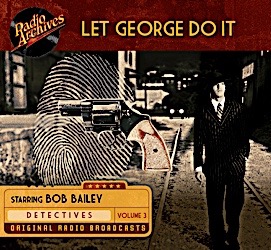



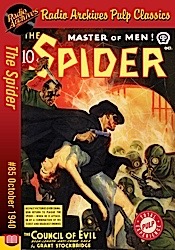

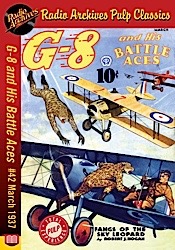
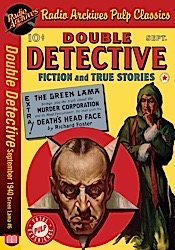
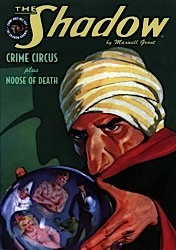
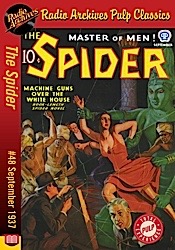
No comments:
Post a Comment